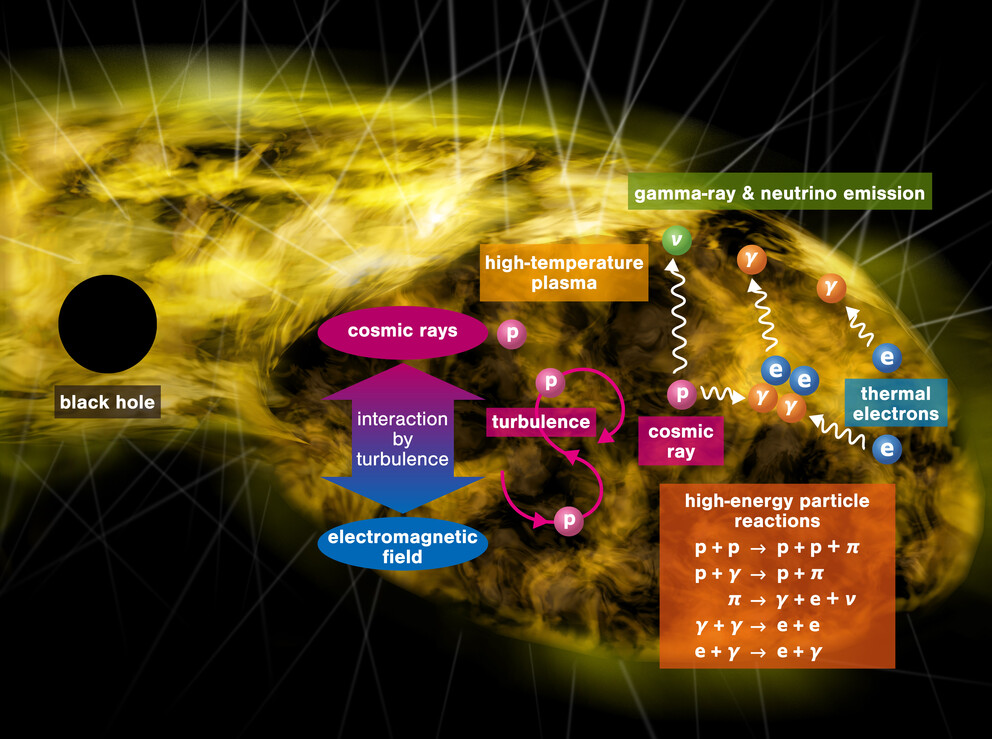According to a novel model suggested by an international research team comprising Penn State scientists, supermassive black holes, even if they are not very active, can be important producers of high-energy cosmic particles in the universe. The journal Nature Communications published an article on Sept. 23 offering a concept that could explain the mysterious connection between reported gamma rays and neutrinos with relatively modest energy measured in the megaelectron volt range.
“Black holes are abundant in the universe, and supermassive black holes have been observed at the centers of galaxies,” said Kohta Murase, an associate professor of physics and astronomy and astrophysics at Penn State and one of the paper’s authors. “In the universe, these monstrous black holes fulfill a variety of roles. They’re expected to be high-energy gamma ray and neutrino emitters, especially active black holes, which are frequently observed with X-rays and gamma rays.”
Gamma rays, which are high-energy photons that are many orders of magnitude more energetic than visible light, and neutrinos, which are subatomic particles with masses so small that they rarely interact with other matter, are produced by energetic cosmic-ray accelerators in the universe, which include extreme astrophysical objects like black holes and neutron stars. Space observatories such as the Fermi gamma-ray telescope have spotted high-energy gamma rays, which have energies in the megaelectron to gigaelectron volt range, and the IceCube neutrino observatory buried beneath the ice in Antarctica has measured high-energy neutrinos. Despite recent theoretical and observational advancements, the origin of these high-energy cosmic particles remains a mystery.
“Active supermassive black holes — also known as active galactic nuclei — are commonly thought to be the most promising emitters of high-energy gamma rays and neutrinos,” according to Murase. “Many jetting active galactic nuclei have been seen using gamma rays, and high-energy neutrino occurrences have also been reported in conjunction with their flares. Recent analyses, however, have found that they are insufficient to explain observed gamma rays and neutrinos, implying that more sources are required.”
According to the new concept, gamma-ray and neutrino factories include not just active black holes, but also non-active, “mellow” objects.
There is no light in a black hole. When matter falls upon a black hole, an accretion disk forms, releasing a massive quantity of gravitational energy. During accretion, the gases in the disk heat up, generating high-temperature plasma. The plasma disk in bright active galactic nuclei cools by efficient radiation. When gas accretion is inefficient, meaning that the black hole is not active, however, the temperature can be maintained at tens of billions of degrees Celsius and gamma rays can be produced. As observed in Sagittarius A, the huge black hole at the heart of the Milky Way galaxy, such mellow black holes are dim as individual objects, but they are numerous in the universe. The researchers discovered that the gamma rays produced by radiatively inefficient supermassive black holes could be a significant source to the observed gamma rays, particularly in the megaelectron volt range.
The new model has some of the physical attributes of a scenario suggested in prior study by the Penn State group, which looked at high-energy neutrino and gamma-ray generation in active galactic nuclei’s high-energy, high-temperature coronal area. Protons can be accelerated to energies more than 100 or 1000 times higher than the Large Hadron Collider, the world’s largest human-made particle accelerator. Because the accelerated protons can produce high-energy neutrinos as a result of interactions with matter and radiation, supermassive black holes — including both active and non-active galactic nuclei — can account for a considerable fraction of the IceCube neutrinos throughout a wide energy range.
Murase stated, “Future multi-messenger observational programs are crucial.” “In the megaelectron volt range, our proposed scenario predicts electromagnetic analogues of neutrino sources in gamma-rays. The Fermi Gamma-ray Space Telescope is one of the few extant gamma-ray detectors that isn’t calibrated to detect them. Observations with future gamma-ray experiments like AMEGO-X, as well as next-generation neutrino experiments like IceCube-Gen2 and KM3Net, would be required to evaluate our novel model.”
In addition to Murase, former Institute for Gravitation and the Cosmos Fellow Shigeo S. Kimura and Eberly Chair Professor Emeritus Peter Mészáros are part of the Penn State study team. The National Science Foundation of the United States, the Japanese Society for the Promotion of Science, the Penn State Institute for Gravitation and the Cosmos, and the Eberly Foundation all contributed to the research.


